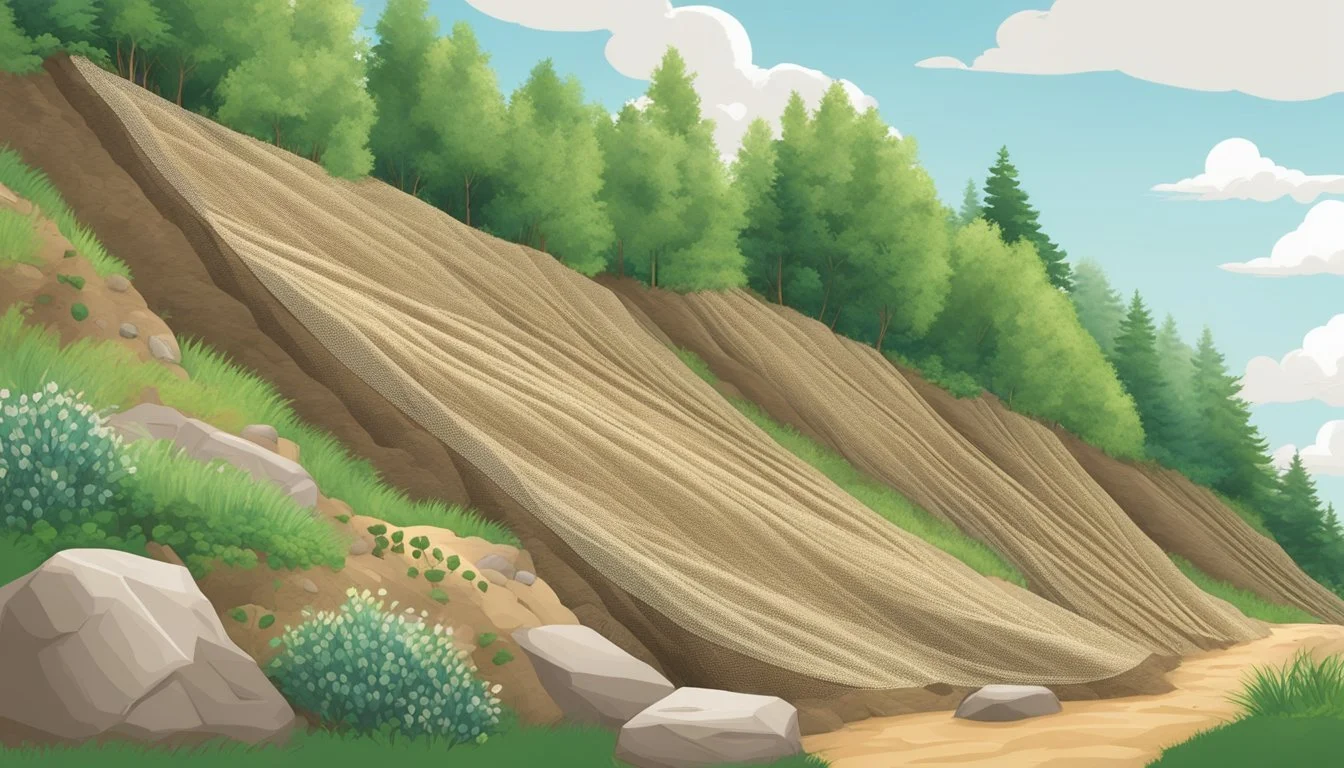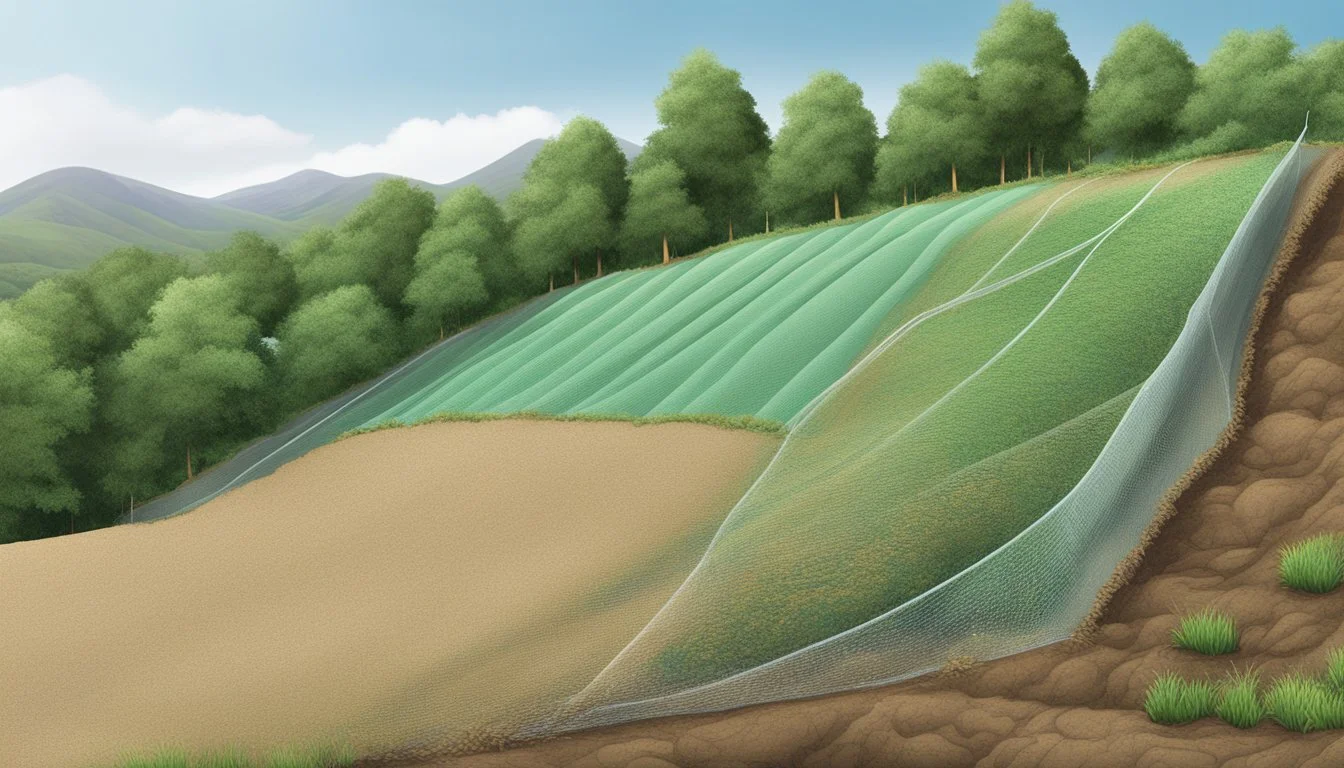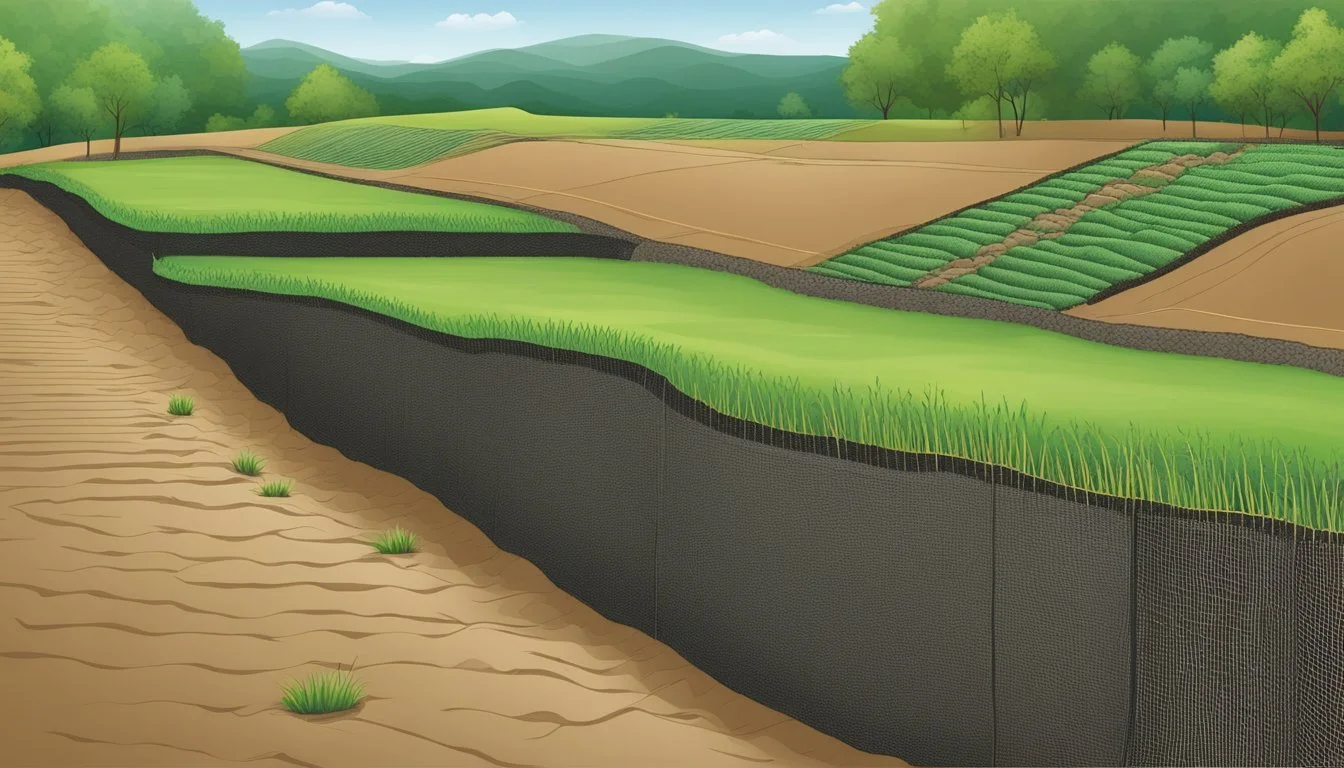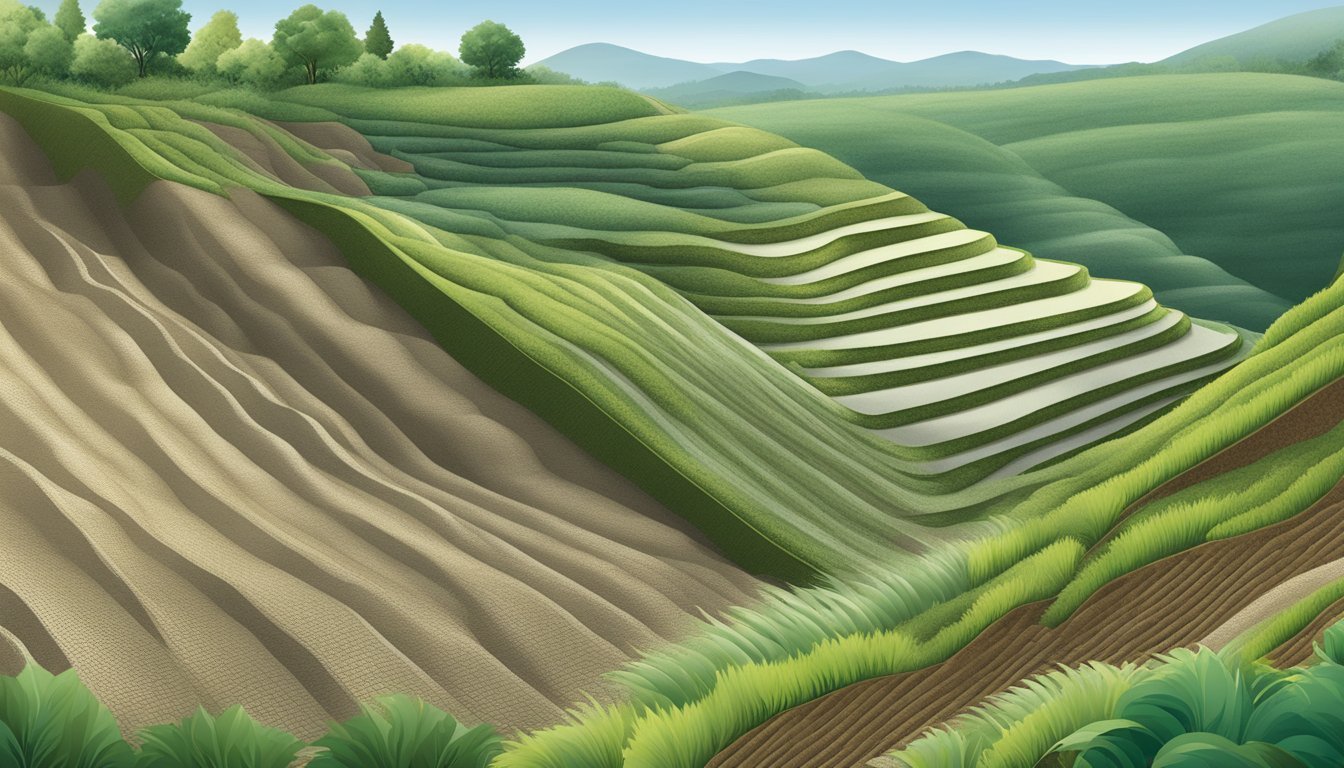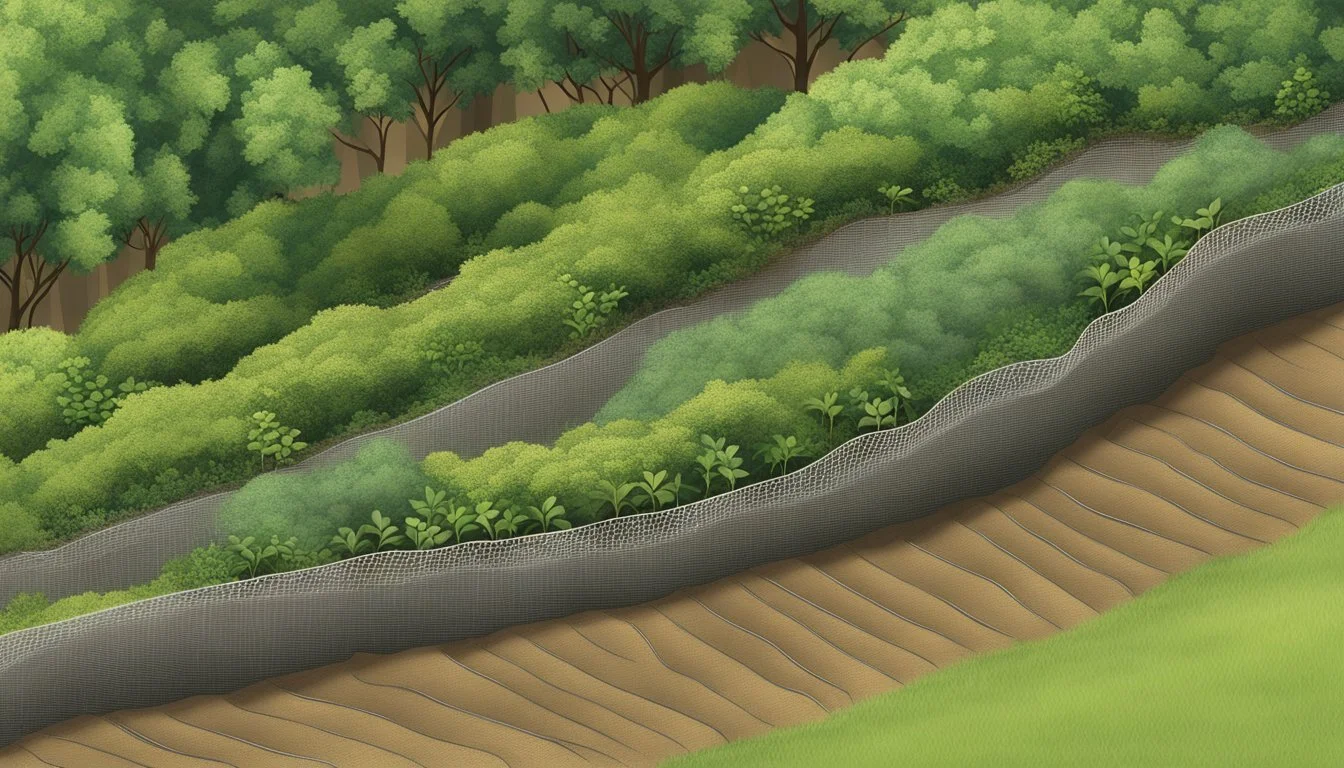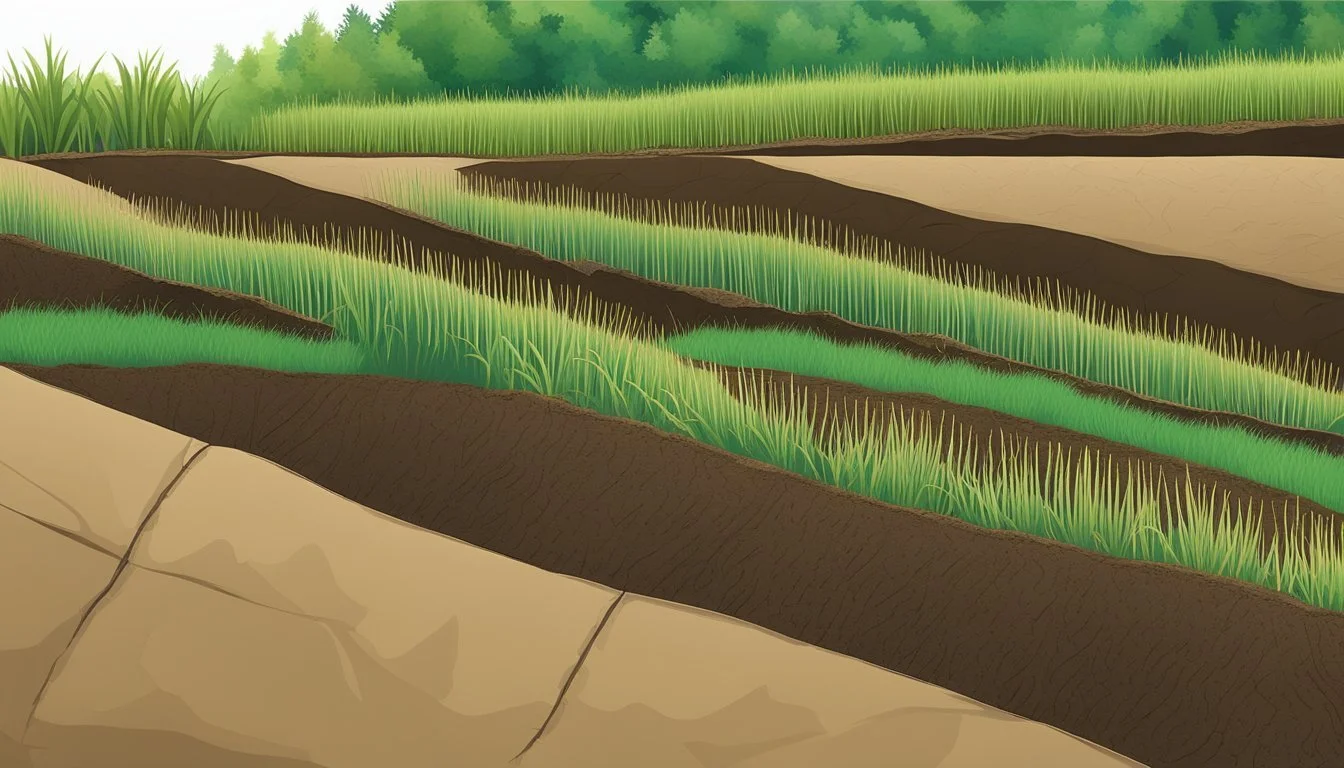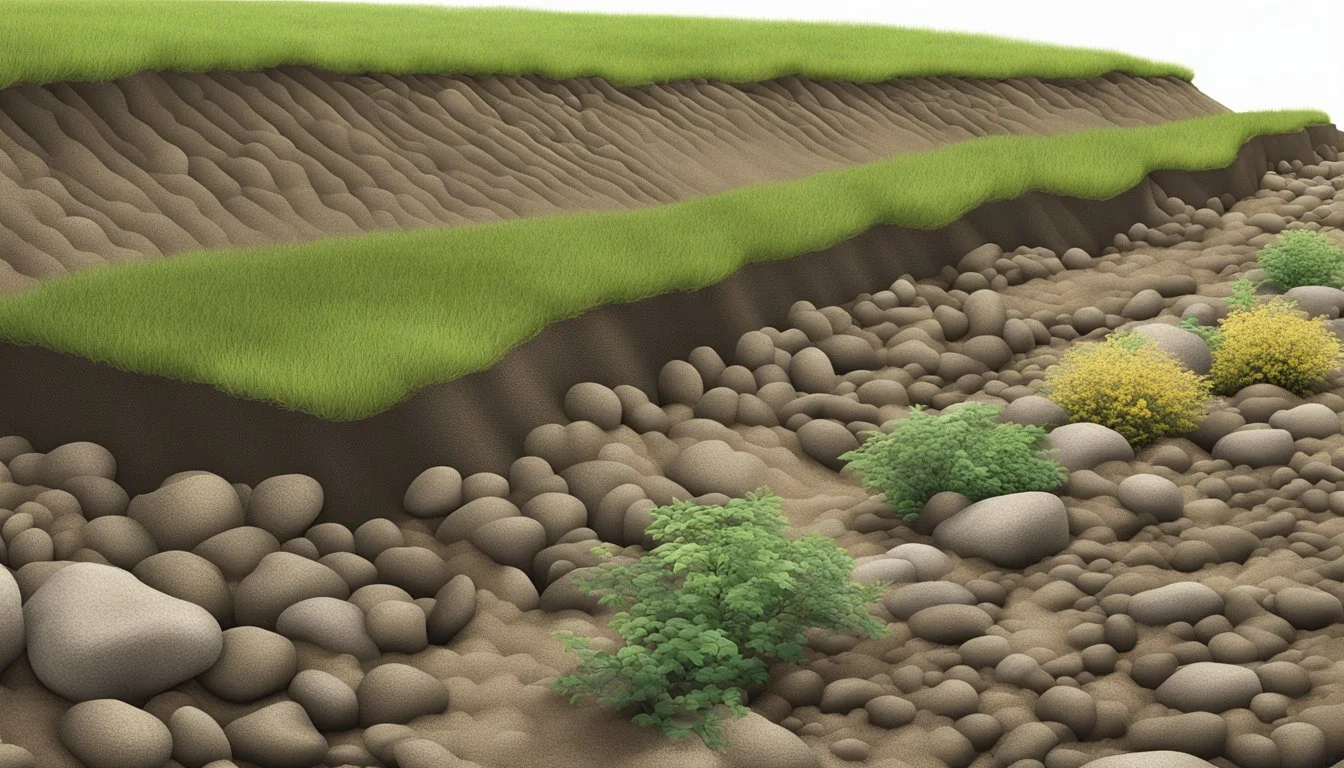The Ultimate Guide to Erosion Control Netting for Slope Soil Protection
Safeguarding Landscapes Effectively
Erosion control netting is a vital tool in the battle against soil erosion, particularly on sloped terrain. Slopes are highly susceptible to the detrimental effects of erosion, which can lead to the loss of valuable topsoil, compromised structural integrity, and increased sedimentation in waterways. This form of soil protection utilises a mesh-like material that provides a barrier against the forces of water and wind, two primary agents of erosion. By securing the soil in place, erosion control netting helps maintain the landscape's natural shape and prevents the dispersal of sediment.
Implementing erosion control netting is not just about immediate soil stabilization; it's also an investment in long-term land conservation and management. When properly installed, the netting supports the growth of vegetation by creating a stable environment for seedlings to root deeply into the soil. As plants establish over time, their root systems enhance the ground's structural stability, further reinforcing the slope against erosion. This method is particularly effective when combined with other erosion control practices, such as planting deep-rooted vegetation and utilizing terracing techniques to diminish water runoff.
Moreover, erosion control netting serves a dual purpose by not only safeguarding the soil but also by encouraging ecological balance. The mesh design allows water and nutrients to pass through, promoting a healthy subsurface environment conducive to plant growth. This harmonious integration of erosion control measures with natural processes underpins a sustainable approach to managing sloped landscapes. Through strategic use of erosion control netting, it is possible to effectively mitigate soil loss while fostering a resilient natural environment.
Understanding Erosion and Slope Stability
In discussing the interplay between erosion and slope stability, it's essential to recognize the causes, effects, and protective measures pertinent to slope soil.
Causes of Erosion
Water Erosion: Rainfall and surface runoff can lead to soil displacement, particularly on unprotected slopes.
Wind: It may carry and deposit soil particles from slopes, exacerbating the erosion process.
Gravity: Gravitational forces contribute to the down-slope movement of soil, especially when the soil's cohesive strength is diminished.
Impacts of Erosion on Slopes
Loss of Vegetative Cover: Erosion strips slopes of grass and plants, reducing the natural anchors for soil.
Reduced Soil Integrity: As soil erodes, the slope's stability is threatened, potentially leading to landslides.
Environmental Impact: Eroded soil can cause sedimentation in nearby water bodies, adversely affecting aquatic ecosystems.
The Basics of Slope Soil Protection
Protective Measures: Incorporating erosion control netting and other stabilizing strategies is vital to maintaining slope integrity.
Material Selection: Choosing the right materials for soil protection is crucial, as they must be durable and suited to the specific type of erosion.
By understanding the causes and impacts of erosion on slope stability, and implementing effective slope soil protection methods, one can mitigate the risks associated with soil erosion.
Types of Erosion Control Netting
Erosion control netting is a key solution for soil stabilization on slopes, offering several types according to material composition and degradation rate. These categories address various environmental needs and soil protection strategies.
Synthetic Netting
Synthetic netting is predominantly made from polypropylene, a durable plastic that resists degradation. It is suitable for long-term erosion control and is typically used in scenarios where extended protection is required. Thanks to its high strength-to-weight ratio, synthetic netting provides excellent soil reinforcement.
Natural Fiber Netting
Natural fiber netting, such as jute and coir, is constructed from plant-based materials. Jute netting is made from long, soft, and shiny fibers that are spun into coarse, strong threads. Coir netting is produced from the fibrous husks of the coconut and is more robust, making it ideal for heavier erosion control applications where natural integration into the environment is preferred.
Biodegradable Netting Options
For environmentally sensitive areas, biodegradable netting presents an eco-friendly solution. These products decompose naturally over time, enriching the soil as they break down. Biodegradable options are often made from natural fibers or other organic materials that are designed to maintain soil integrity while plants establish roots, after which they will decompose. This can include nets made of jute, coir, or other organic materials that integrate into the environment without leaving behind synthetic residues.
Preparatory Steps for Installation
Proper preparation is essential for the successful installation of erosion control netting on slopes. This involves meticulous site assessment and planning, as well as soil analysis and amendments, ensuring compatibility between the project requirements and the site conditions.
Site Assessment and Planning
A thorough site assessment sets the stage for effective erosion control netting installation. This assessment must document slope gradient, existing vegetation, and potential erosion rates. Planners should delineate areas requiring protection and create a layout for the netting that conforms to the natural topography. Mapping runoff patterns is vital to anticipate where erosion control measures will be most needed. Pre-installation planning should also include the identification of the proper materials and equipment for the site's specific conditions.
Checklist for Site Preparation:
Map the site topography and runoff patterns.
Mark the areas for netting installation.
Select appropriate netting material based on the site and environmental needs.
Ensure all necessary tools and equipment are available and suitable for the soil and slope conditions.
Soil Analysis and Amendments
Analyzing the soil type is critical as it influences the choice of soil amendments and anchoring techniques for the erosion control netting. Different soil types, such as loamy, sandy, or clayey, have distinct properties affecting water absorption rates and susceptibility to erosion. Planners need to consider these factors and perform tests like soil texture analysis or shear testing to determine the appropriate netting and stabilization strategies.
Soil Amendments: Depending on the results of the soil analysis, planners may decide to integrate organic or inorganic amendments to enhance soil structure, promote vegetation growth, and improve water retention capabilities. The strategic use of amendments can substantially increase the effectiveness of erosion control netting by fostering a more stable and cohesive soil environment.
Determine soil type through analysis.
Identify required amendments to optimize the soil for planting and to support the netting.
Apply amendments evenly across the site as needed to create a robust foundation for the netting and vegetation.
Installation Techniques for Erosion Control Netting
Successful erosion control on slopes hinges on proper installation techniques, ensuring effective slope stabilization and soil protection. These methods are critical for the longevity and effectiveness of erosion control measures.
Anchoring and Staking Methods
To anchor erosion control netting effectively, start by preparing the site with a 6-inch trench at the bottom of the slope for anchoring. The netting should extend into the trench, ensuring it is securely anchored. Use stakes or staples at regular intervals to fasten the netting to the ground. Staples should be placed every 12 inches within the trench. For optimal stabilization, the upper end of the netting should be anchored in a similar trench at the top of the slope.
Stapling Technique:
Ensure staples are U-shaped and at least 6 inches in length.
Drive staples vertically into the soil to secure edges and seams between netting sections.
Space staples every 1 to 2 feet along the netting within the trench.
Staking Technique:
Use stakes that are sufficiently long to penetrate the ground.
Space stakes approximately 2 to 3 feet apart along the netting perimeter.
Install stakes at a slight angle away from the slope to resist pullout.
Laying and Securing Netting on Slopes
When laying netting, unroll it from the bottom of the slope upwards to prevent soil movement and promote even coverage. It's crucial to overlap each section of netting by approximately 3 inches and secure these overlaps with staples or stakes to prevent soil and water from penetrating these spaces.
Laying Techniques:
Start at the bottom of the slope, allowing an additional 6 inches of netting to anchor in the trench.
Roll the netting up the slope, not down, to ensure proper soil contact and stability.
Ensure the netting lies flat against the soil before anchoring to eliminate gaps where erosion could occur.
Securing the Netting:
After unrolling, secure the netting with staples or stakes along the perimeter and throughout the center area.
Additional security measures should be taken on steeper slopes, including closer spacing of staples and deeper anchoring trenches.
Inspect the installation to make sure there are no areas where water runoff could undermine the netting.
Planting Strategies with Erosion Control Netting
Proper seedling and seed selection, along with meticulous vegetation growth and management, can significantly bolster the effectiveness of erosion control netting for slope soil protection.
Seedling and Seed Selection
Choosing the appropriate seedlings and seeds is crucial for establishing a successful erosion control netting system. It is important to select species that are not only conducive to the local climate but also possess robust root systems for soil stabilization. For grass seed, varieties such as fescue or ryegrass are often recommended for their fast growth and soil binding properties.
Grass Seeds:
Fescue: Adaptable to a range of soils; deep-rooted.
Rye: Quick germination; effective soil cover.
With trees and shrubs, they should be selected based on their ability to thrive on slopes and their compatibility with the netting material.
Trees and Shrubs:
Evergreens: Provide year-round cover; stabilize soil.
Deciduous Trees: Offer seasonal foliage; roots help soil retention.
Vegetation Growth and Management
Once the seeds or seedlings are planted, ensuring proper vegetation growth is essential. This typically involves routine maintenance such as watering, weeding, and monitoring growth patterns to reinforce the soil beneath the erosion control netting.
Initial Growth Phase:
Water regularly to ensure seed germination and seedling survival.
Thin out overgrowth to prevent competition for nutrients.
Ongoing Management:
Periodically check the integrity of the netting and its adherence to the soil.
Replace or supplement vegetation as needed to maintain dense, protective coverage.
By using a combination of strategic planting and diligent management of vegetation under and around the netting, erosion on slopes can be effectively mitigated.
Additional Erosion Control Measures
In addition to erosion control netting, there are reliable and effective strategies for soil protection on slopes that include the construction of terraces and retaining walls, as well as the application of hydroseeding and mulching techniques.
Using Terraces and Retaining Walls
Terraces are effective in breaking long slopes into shorter segments, which reduces the velocity of water flow and minimizes soil erosion. By constructing terraces across the slope, one can create level, step-like areas that offer more manageable grades for planting and maintenance. This method also aids in flood and sediment control.
Retaining walls provide immediate support for steep slopes, preventing the downward movement of soil. They are constructed from a variety of materials, including concrete blocks, natural stone, and timber. Retaining walls can be an essential part of an erosion control strategy as they offer a strong barrier that holds soil in place and redirects water flow.
Materials for Retaining Walls:
Concrete: Durable and strong.
Stone: Naturally blends with the environment.
Timber: Economical and suitable for garden terraces.
Hydroseeding and Mulching Techniques
Hydroseeding is a method that involves spraying a slurry mixture of seeds, mulch, fertilizers, and binding agents over the soil. This technique promotes quick vegetation growth which stabilizes soil and protects against erosion. It is particularly valuable on slopes where planting is impractical due to steepness or accessibility.
Mulch is applied to soil surfaces to protect from erosion by water and wind. It absorbs the impact of raindrops and reduces the speed of running water. Organic mulches such as straw or wood chips not only provide protection but also contribute to soil health by decomposing and adding nutrients.
Benefits of Hydroseeding and Mulch:
Quick establishment of vegetation.
Enhances soil moisture retention.
Offers temporary protection while plants are establishing.
Employing these additional erosion control measures can significantly improve slope stability and contribute to long-term soil protection.
Maintenance and Monitoring
Effective maintenance and monitoring are crucial for ensuring the longevity and stability of erosion control netting on slopes. Proper care guarantees that the netting continues to perform its erosion management functions over time.
Routine Inspection
Frequency: Inspections should occur at least bi-annually, with additional checks following severe weather events.
Checkpoints:
Integrity: Examine the netting for signs of wear, such as fraying or tearing.
Anchor Points: Ensure all stakes or anchors remain secure.
Vegetative Growth: Assess whether plants are growing as expected and reinforce areas with poor vegetation.
Long-Term Stability and Repair
Monitoring: A systematic approach is essential to track changes in soil stability and vegetation health.
Utilize documentation from routine inspections to identify patterns or recurring issues.
Repair Strategy:
Prompt Response: Address any identified damage to the netting or anchors immediately.
Material Assessment: Evaluate whether the existing netting material is suited to the site conditions or if upgrades are necessary.
Vegetation Management: Healthy plant growth is integral to slope stability and should be managed alongside the netting. Consider seasonal care and potential replanting for eroded areas.
Benefits of Erosion Control Netting
Erosion control netting offers a range of benefits that are both environmentally beneficial and economically advantageous.
Environmental Benefits
Erosion control netting provides several key environmental benefits:
Biodegradability: Netting made from natural fibers like jute and coconut is eco-friendly because over time, it decomposes and merges with the soil, reducing environmental impact.
Wildlife Protection: Netting that is loosely woven with movable joints, like leno or gauze, is preferred for being wildlife-friendly, offering protection without causing harm to animals.
Economic and Landscaping Advantages
Erosion control netting also presents economic and landscaping advantages:
Soil Stabilization: It preserves topsoil, essential for healthy landscaping, by preventing soil displacement, which secures long-term plant growth.
Cost-Effectiveness: With proper implementation, the netting reduces the need for frequent maintenance and landscaping restoration, resulting in economic benefits.
Selection Guides and Best Practices
When protecting slopes from soil erosion, the selection of the right netting is crucial to ensure long-term stability and environmental compliance. Industry experts provide invaluable guidance to optimize this process.
Choosing the Right Netting for Your Slope
Specifications: Choosing the appropriate netting hinges on understanding the specific characteristics of the slope under consideration. A proper assessment should consider factors such as slope angle, soil type, climatic conditions, and the potential for vegetation growth. The selection process should align with the grade of the slope. Steep slopes (greater than 50-percent slope gradient) necessitate heavy-duty, durable erosion control netting, while gentler slopes may be adequately protected with lighter materials.
Mesh Size: The size of the mesh openings is pivotal as it affects the netting's ability to allow for vegetation while still providing soil protection. Smaller mesh openings might be used in areas with fine soil particles, while larger mesh might be better for coarser soils.
Material Durability: Synthetic materials such as polyethylene or natural fibers like coir can be used depending on the desired longevity and environmental impact. Synthetic nets tend to be more durable but less environmentally friendly, whereas natural fibers are biodegradable but may have a shorter lifespan.
Installation Requirements: It is also necessary to consider the installation costs and the labor involved, as some netting options may require professional installation or special equipment.
Tips from Industry Experts
Best Practices: Industry experts emphasize the importance of a strategic approach to erosion control that balances cost-effectiveness with environmental protection. They recommend integrating erosion control measures early in the project planning phase to minimize the need for costly remediation later.
Implementing erosion and sediment control best management practices (BMPs) is crucial, as outlined by the Municipal Separate Storm Sewer System (MS4) permits.
Establishing a construction sequence schedule can guide when to install netting relative to other land-disturbing activities, ensuring maximal soil protection during critical phases of construction.
Regular inspection and maintenance of erosion control netting help in identifying potential issues early and extending the lifespan of the control measures.
Case Studies and Real-world Applications
Erosion control netting has proven its efficacy in various settings, from the sophisticated demands of large-scale constructions to the meticulous care required in residential landscaping projects.
Residential Landscaping Projects
Erosion control netting plays a pivotal role in maintaining the integrity of residential landscapes, where it helps to prevent soil displacement caused by wind and water. In a case study from Meadowview Open Space, erosion was countered by laying back a headcut to a slope of 3:1, compacting the soil, and then applying seed spread and rock mulch. This methods helped stabilize the slope and facilitated the growth of vegetation, which further contributed to soil protection.
Large-scale Construction and Restoration
On a larger scale, construction projects employ erosion control netting extensively to safeguard against the mass wasting of slopes. For example, the soil bioengineering and biotechnical methods highlighted Wiley's comprehensive guide indicate cost-effective, sustainable approaches to such projects. These approaches align with environmental concerns and are characterized by strategic planting and the use of organic materials to reinforce the soil structure. In such applications, netting is vital for keeping the engineered solutions in place, especially during the establishment phase of the vegetation.
Future Trends in Erosion Control Technologies
Erosion control technology is rapidly advancing, with sustainable solutions and innovative designs at the forefront of the industry.
Innovations in Biodegradable Materials
Researchers and manufacturers are focusing on biodegradable materials that can provide effective soil protection while minimizing environmental impact. The integration of biodegradable nettings made from natural fibers is a significant advancement. These materials decompose over time, adding organic matter to the soil. They are designed to provide immediate erosion control and support vegetation growth, thereby offering both immediate and long-term benefits.
Key Components of Biodegradable Materials:
Natural fibers: coir, jute, straw
Decomposition rate tailored to project needs
Dual functionality: erosion control and soil enrichment
Advances in Engineering and Design
The application of engineering principles and design innovations is transforming erosion control. State-of-the-art technologies involve precise modeling tools for predicting soil erosion patterns and the efficiency of control methods. This allows for the creation of tailored erosion control systems that fit the unique topography and environmental conditions of a site. With advanced engineering design, erosion control solutions are more effective, with a focus on long-term sustainability and minimal maintenance requirements.
Engineering Advancements:
Predictive modeling software for soil erosion patterns
Design optimization for site-specific applications
Low-maintenance, high-durability materials
Erosion control technologies are evolving to meet the dual demands of efficacy and environmental sustainability, utilizing innovations in both biodegradable materials and engineering design to protect soil resources for future generations.
Conclusion
Erosion control netting is an integral part of managing soil protection on slopes, especially amidst varying climate conditions. The use of erosion control blankets and geotextile bags has proven effective in providing immediate soil stabilization.
Erosion control blankets work by protecting newly planted areas from erosion, while aiding in vegetation growth.
Geotextile bags, on the other hand, offer a more structured solution, especially beneficial in areas where stronger forces due to water or wind are present.
Compliance with local laws and regulations is crucial when implementing these erosion control measures. Authorities often have guidelines in place to ensure that soil protection strategies do not have adverse environmental impacts.
When choosing an erosion control strategy, it is important to consider the climate of the area. Erosion control methods should be capable of withstanding the local weather patterns and seasonal changes, providing long-term soil stabilization.
Professionals should adopt these erosion control techniques as part of their soil protection and slope stabilization plans. By doing so, they not only adhere to best practices in civil engineering and environmental stewardship but also contribute to the sustainable development of our landscapes.
Glossary
Erosion Control Netting: A mesh material used to protect soil on slopes from erosion by wind and water. It provides a structure for vegetation to establish.
Geobags: Fabric containers filled with soil, sand, or similar materials used for erosion control and stabilization of slopes and embankments.
Slope Stabilization: Techniques and practices aimed at preventing the movement and erosion of soil on a slope.
Embankment: An artificial mound of soil and rock built to hold back water or support a roadway or pathway.
Vegetative Growth: Plant cultivation intended to cover and protect soil from erosion.
Reinforcement Support: The use of structural elements, such as rock bolts or shotcrete, to strengthen and stabilize slopes.
Terracing: The creation of flat areas on a slope to reduce erosion and runoff.
Retaining Walls: Structures designed to hold back soil in areas where a sharp change in elevation occurs.
The glossary provided aims to clarify technical vocabulary related to erosion control netting for slopes. One must understand these terms to appreciate the diverse methods available to combat soil erosion effectively. Erosion control netting anchors the soil and ensures that seeds have the opportunity to take root. Geobags serve as a supportive barrier, and when coupled with vegetative growth, can form a strong defense against soil displacement. Additionally, reinforcement support techniques can prove invaluable to ensure a slope's longevity. The strategic use of terracing and retaining walls also plays a significant role in comprehensive erosion control strategies.
References
The body of knowledge surrounding erosion control netting for slope soil protection is extensive, with numerous studies and publications contributing to the field. Here are key references that professionals and stakeholders may find invaluable:
Journals:
"Journal of Soil and Water Conservation": Provides peer-reviewed research on soil erosion topics, including the effectiveness of erosion control netting.
"Geotechnical and Geological Engineering": Offers technical papers on slope stabilization methods.
Publications:
"Slope Stability and Erosion Control: Ecotechnological Solutions": This reference compiles various eco-friendly technologies and their application to erosion control.
Studies and Reports:
"USDA National Resources Conservation Service" studies: Their research into soil conservation techniques includes netting applications.
"FHWA Slope Stabilization and Erosion Control: A Basic User Guide": Delivers practical advice for stabilizing slopes, highlighting the use of netting.
Selected Article Citations:
"Geosynthetics for Erosion Control on Slopes" - Documents case studies showing the application of geosynthetic netting in real-world scenarios.
"Biotechnical and Soil Bioengineering Slope Stabilization" - A detailed review of biotechnical methods, including the use of erosion control netting.
The above references represent a robust framework for understanding and utilizing erosion control netting. The listed journals and publications are a starting point for those seeking to deepen their knowledge in the area of slope soil protection.
About the Author
The author, Dr. Sierra Martin, possesses a distinguished background in environmental engineering with a focus on soil conservation and erosion control. Dr. Martin earned her Ph.D. from the Massachusetts Institute of Technology (MIT) where she specialized in Geotechnical Engineering.
Credentials:
Ph.D. in Geotechnical Engineering, MIT
M.Sc. in Environmental Engineering, Stanford University
B.Sc. in Civil Engineering, University of California, Berkeley
Dr. Martin has over 20 years of experience in the field of slope stabilization and has contributed to numerous projects worldwide that address soil erosion and land degradation. She's a published author of several influential papers in top peer-reviewed journals and has presented her findings at international conferences.
Professional Experience:
Lead designer for bioengineering slope stabilization projects in South America and Southeast Asia.
Consultant on sustainable erosion control methods for the United Nations Environmental Programme (UNEP).
Keynote speaker at the International Conference on Soil and Erosion Control.
Her expertise encompasses the integration of bioengineering techniques with traditional soil stabilization methods. Dr. Martin is known for her innovative approaches to sustainable land management, advocating for the use of erosion control netting as a cost-effective and environmentally friendly solution.
Specializations:
Bioengineering techniques for slope protection
Innovative erosion control materials, including erosion control netting
Sustainable land management practices
Dr. Martin's extensive fieldwork and academic research inform her authoritative perspective on soil protection strategies, making her guide an invaluable resource for practitioners and students alike. Her work emphasizes the importance of a balanced ecosystem approach to maintaining soil integrity on slopes and other vulnerable landscapes.
Contact Information
For any inquiries regarding erosion control netting and its application on slopes, interested parties can reach out through multiple avenues. Several organizations and manufacturers dedicate themselves to providing expert advice and top-of-the-line products for effective soil protection.
Customer Service and Product Inquiries:
Phone:
+1 (800) 555-1234 (Toll-Free)
+1 (800) 555-5678 (International)
Email:
Live Chat:
Available on the company website during business hours (9 am - 5 pm EST)
Technical Support and Installation Guidance:
Technical Hotline:
+1 (800) 555-9876 (Available 24/7)
Email:
Distribution and Bulk Orders:
Sales Department Phone:
+1 (800) 555-3456
Email:
For face-to-face consultations and on-site assessments, clients can schedule appointments with regional experts. Contact details for local representatives are accessible on the 'Contact Us' page of the company’s official website.
The team ensures customer satisfaction by providing clear and concise information tailored to each unique situation. By contacting the appropriate department, clients will receive efficient service and the necessary resources for their soil stabilization needs.
Frequently Asked Questions
What is erosion control netting?
Erosion control netting is a biodegradable or synthetic material used to protect soil on slopes and prevent erosion. It helps stabilize the area, allowing vegetation to take root and further secure the soil.
How is netting installed on a slope?
Installation Steps:
Trenching: A trench is dug at the top of the slope.
Securing: The netting is secured to the trench using staples or stakes.
Unrolling: The netting is then unrolled down the slope.
Anchoring: Finally, the netting is anchored to the soil to keep it in place.
Can netting be used on any type of slope?
Netting is suitable for a variety of slopes but may be more beneficial on those with a grade no steeper than 50%, where alternative solutions like terracing may be required for steeper grades.
What materials are used for erosion control netting?
Common materials include:
Jute: A natural biodegradable option made from plant fibers.
Synthetic: Longer-lasting materials like polypropylene.
When should vegetation be planted for erosion control?
Vegetation should be planted during the netting installation process to ensure roots help stabilize the soil as they grow, with plant selection depending on the steepness of the slope.
Are there any alternatives to netting for slope protection?
Alternatives include:
Erosion Control Mats: Often used in conjunction with netting for additional support.
Geobags: Used for more severe erosion issues, providing slope stabilization.
Retaining Walls: Recommended for very steep slopes.
Additional Resources
For those seeking to deepen their understanding of erosion control netting and soil protection on slopes, a wealth of external resources are available. The following list provides valuable avenues for further reading and exploration:
Books and Guides:
"Soil Erosion and Conservation" by R. Morgan
"Erosion Control and Land Restoration" by Pablo A. Garcia-Chevesich et al.
Professional Journals:
Journal of Soil and Water Conservation
The International Journal of Geo-Engineering
Organizations:
International Erosion Control Association (IECA)
Soil and Water Conservation Society (SWCS)
Online Resources:
USDA National Resources Conservation Service: Provides guidelines and technical resources
Erosion Control Technology Council: Offers product specifications and case studies
Educational Videos:
YouTube channels dedicated to soil conservation and land management
Conferences and Workshops:
Professionals can attend the IECA Annual Conference for workshops and networking opportunities.
Regional seminars and webinars focusing on sustainable practices in erosion control.
Researchers and practitioners are encouraged to consult these resources to gain further insights into innovative materials, techniques, and case studies relevant to their work. It is essential for professionals to stay abreast of the latest research and recommendations in the field of erosion control to ensure the effectiveness and sustainability of soil protection strategies on slopes.
Acknowledgments
The production of this ultimate guide to erosion control netting for slope soil protection was made possible through the collective efforts of a dedicated team of environmental experts, engineers, and researchers. Their extensive knowledge and experience have been instrumental in compiling the comprehensive information contained within these pages.
Research Contributors: Scientists and researchers from the field of soil erosion and conservation have provided invaluable data and theoretical foundations through their rigorously peer-reviewed studies.
Engineering Professionals: Experienced engineers specializing in geotechnical and environmental engineering have contributed practical insights into the implementation of erosion control netting.
The editors also extend their gratitude to the organizations that have collaborated on this project by sharing case studies, providing access to sites for field research, and assisting with logistic support.
Professional Collaborators:
BMP Supplies Inc.: For offering detailed insights on the selection process of erosion control blankets suitable for varying soil types and environmental conditions.
Environmental Consultants: A special mention to consultants who advised on best practices for installation and maintenance of erosion control systems.
Lastly, the authors acknowledge the feedback from the initial readers whose observations and suggestions have helped refine the guide into its current form. Their engagement has been crucial in ensuring that the information presented is not only accurate but also user-friendly and accessible.
The cooperative spirit of all involved has been vital to the purpose of this guide: to enable effective slope soil protection and to promote environmental sustainability.
Legal Disclaimer
This article provides information on erosion control netting for slope soil protection. It is intended for educational purposes and should not be considered as legal advice. Readers are responsible for complying with local, state, and federal regulations applicable to erosion control and environmental protection.
Accuracy of Information:
The contents are current as of the article's publication date.
All efforts have been made to ensure the accuracy of the information.
The publishers do not warrant that the information is exhaustive or without error.
Usage of Erosion Control Netting:
Users must consult with a professional engineer for site-specific recommendations.
Adherence to the manufacturer's guidelines and industry standards is crucial.
Installation must comply with environmental and safety regulations.
Legal Considerations:
Laws and regulations regarding slope stabilization and erosion control vary by region.
Non-compliance with legal standards can result in fines or legal action.
Readers must obtain necessary permits and approvals from relevant authorities.
Liability:
The publishers and authors accept no liability for any damage or loss resulting from the use of this guide.
Any reliance on the material provided is at the reader's own risk.
For specific legal issues or concerns, consult a qualified attorney.

